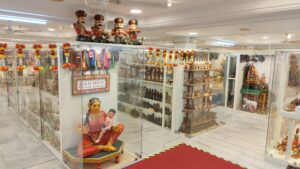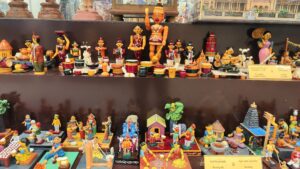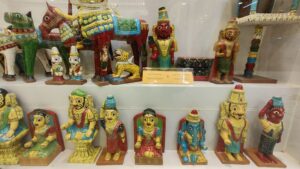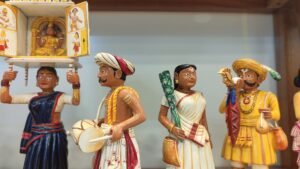
Jumbo Sawari Procession display at the Kaladevi Doll Museum. (Rashmi Gopal Rao)
Dussehra is that time of the year in India when the feminine energy is worshipped and celebrated across the country. In the south of India, for these nine days, Golu becomes intrinsic to the celebrations. Dolls are placed in a step-like arrangement and considered to be highly auspicious and a symbol of divinity. Along with Goddess Durga, the dolls are also worshipped during this period called Navaratri.

A view of Kaladevi Doll Museum. (Rashmi Gopal Rao)
If this tradition piques your curiosity, the Kaladevi Doll Museum in Mysuru is the place to visit. Opened on World Tourism Day this year, this venture is spearheaded by Ramsons Kala Pratishtana (RKP), a non-profit art foundation based in Mysuru. Incidentally, the famous doll emporium Bombe Mane is also a part of RKP. The Kaladevi Doll Museum has been set up as part of the 50th-anniversary celebrations of Ramsons Handicrafts Sales Emporium founded by D. Ram Singh in 1970. It is located in the cellar of the emporium.
The museum houses over 5000 dolls, which have been painstakingly collected over the last few decades.
“The tradition of doll making is spread across different regions in India. We have dolls crafted from all over India in this museum. Not only does this help keep native art forms alive but also showcases our unique traditions to future generations,” says Raghu Dharmendra, art historian at RKP. The dolls here are arranged thematically — according to a tradition, a ritual, a specific doll cluster and such.

Display of Channapatna and Kondepalli dolls at Kaladevi Doll Museum. (Rashmi Gopal Rao)
The museum also has a miniature collection of the founder’s wife, Kaladevi. Most of the dolls in the museum have been specially commissioned and made by reputed artists in the field. Whether it is dolls depicting the Vitthal Varkari movement of Maharashtra (Varkari is a school of Bhakti with the Vithoba or Vitthal being the main deity worshipped) or the royal family of Mysore or the tradition of Gowri puja in Kohlapur and Karnataka, you can find them all here. The celebration of Navaratri in Vrindavan is also depicted. There are also dolls depicting the various forms of Goddess Durga.
“We have a section called Nanda Govinda which showcases the different indigenous cow breeds of India. While most of them have been crafted by the artisans of Kinnal, we have got the unique patterns on each of them crafted locally” adds Raghu.
Dolls specially designed by the RKP team like the peg dolls and Navarasa dolls (dolls depicting the nine rasas) are also on display. There are dolls made from various materials like wood, paper mache, clay and even porcelain. Further, there are several pairs of the quintessential Marapachi dolls, also known as Marapachi Bommai which represent the ideal and happily married bride and groom.
The Kaladevi Doll Museum has dolls representing various craft clusters like the Cheriyal, Kinnal and Channapatna. There is a section of Cheriyal dolls that is an art form native to Telangana.

Display of Cheriyal dolls at the museum. (Rashmi Gopal Rao)
They were used in traditional storytelling performances. This dying art form is an ancient craft and the dolls are made of lightweight wood and sawdust. They are treated with Khadi cloth and painted with natural, eco-friendly pigments. The dolls of Kinnal of North Karnataka which trace their origin to the 15th century are also on exhibit. The section which depicts the different kinds of namams sported on the forehead along with their storage boxes has been crafted in the Kinnal style. Apart from this, there are dolls native to Channapatna in Karnataka, Etikoppaka and Kondepalli of Andhra Pradesh as well as the ceramic dolls of Neyveli in Tamil Nadu.
There are several eye-catching dioramas that have been curated with utmost attention to detail. One such display is that of Goddess Banashankari of Badami. She is known to be the patron deity of fruits and vegetables. The exquisitely crafted vegetables including a quirky wedding scene between a brinjal and pumpkin have been wonderfully created. Another exclusive display is dolls inspired by company paintings, a school of painting that emerged in India during the 18th century. These premium dolls depict people from all walks of life. They provide an insight into the life and times of India under the East India Company.

Dolls inspired by Company paintings. (Rashmi Gopal Rao)
“They have been specially made in Jodhpur. Each of them has been carved out of a single block of wood,” Raghu shares.
Arguably the museum’s highlight is the diorama that recreates the scene of the famous 1939 Mysore Dusshera procession. Consisting of innumerable soldiers, decorated elephants, musicians, horses, royal insignias and flags, all against the backdrop of the beautiful Mysore palace, this creation makes the renowned Jumbo Sawari come alive. According to Raghu, this set which has about 800 dolls is still a work in progress. The intricate craftsmanship and the level of detailing on the dolls are simply unmissable.
Besides all these, the museum has a small collection of dolls from abroad. It includes a set of Barbie dolls created to mark Barbie at 60 and small handmade Thai worry dolls.